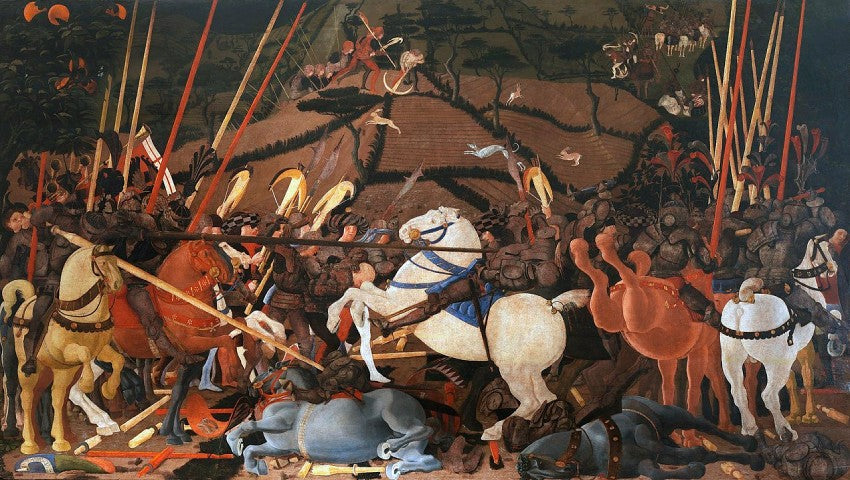
The Battle of San Romano
Alice PettirossoShare
The Battle of San Romano: an epic duel in the heart of the 15th century
The Battle of San Romano , fought on 1 June 1432 , is one of the most fascinating clashes in Italian history . Florence and Siena , the two great rival cities , faced each other for control of the trade routes and the rich Tuscan lands . It was the height of the fifteenth century , an era marked by incessant wars and struggles for territorial supremacy , in which power oscillated between delicate balances and fragile alliances.
San Romano , a small Tuscan village , was transformed for a day into the hub of the ambitions of these two city-states . It was not only a military battle , but also a clash between two political and strategic visions. This is demonstrated by the chronicles of the time and, even more, by art : Paolo Uccello , with his famous triptych , immortalized the battle in a world suspended between reality and legend, inspired by the aesthetics of the chivalric romances of the late Middle Ages .
Other contemporary conflicts, such as the Battle of Anghiari in 1440 , also highlighted the fragility of the balance of power in Renaissance Italy . But the Battle of San Romano stands out for its strategic importance and the participation of some of the most renowned leaders of the time . A decisive day, which Paolo Uccello made eternal through his art .
Armies in comparison: strategy, commanders and mercenaries
On the day of the clash, the two armies were ready for anything. On one side was Florence , led by the famous leader Niccolò da Tolentino . His experience and cunning had made him a feared and respected commander . Under his leadership, Florence fielded an impressive army : mercenary knights , citizen troops and the fearsome heavy cavalry . These men were determined to defend the city's honor at any cost.
On the other side, the army of Siena was led by Bernardino della Carda , a commander of proven ability. Some sources also suggest the presence of another well-known leader, Francesco Piccinino , making the battle even more fascinating. The Sienese troops were equally varied: expert infantry, knights and crossbowmen , supported by mercenaries . In that era, the recruitment of professional soldiers was a common practice, fundamental to resolving conflicts between the states of the peninsula .
Paolo Uccello 's artistic interpretation: In his paintings, Paolo Uccello transforms the rawness of the clash into an almost dreamlike scene. The elements of the battle – broken lances , shields and armour – are arranged according to a rigorous perspective , creating a perfect geometric grid. This representation is influenced by the Renaissance , especially the obsession with perspective and symmetry, also clearly visible in the works of Piero della Francesca .
Victory and its aftermath: the geopolitical impact of the clash
The battle ended with a victory , although not overwhelming, for Florence . The Florentines managed to halt the Sienese advance and consolidate their dominion over the region . However, the conflict between the two cities did not end that day: it continued for years, alternating armed clashes and political negotiations.
The impact of the battle went beyond the simple result on the field. Florence , strong with this success, managed to strengthen its hegemonic position in Tuscany and to increase its influence in relations with other city-states such as Milan and Venice . Paolo Uccello's work expresses this complexity: his paintings, with the use of precious materials and geometric details , give the battle an atmosphere of unrealism , transcending the simple historical chronicle.
Art and War: Paolo Uccello's Triptych Between Heroism and Perspective
Paolo Uccello's artistic contribution is what makes the Battle of San Romano a true myth. In the three panels , now scattered among three museums, the artist immortalizes the key moments of the clash .
" Niccolò da Tolentino at the Head of the Florentines " ( National Gallery, London ): Paolo Uccello represents the leader at the moment of the attack. The scene is dominated by the power of the cavalry and by an impeccable geometric order . Niccolò da Tolentino , with his helmet surmounted by a feather, is the symbol of courage and authority .
" Unhorsed Bernardino della Carda " ( Uffizi, Florence ): The dramatic moment of the unhorsed Sienese commander . The perspective and dynamism capture the essence of the battle, transmitting tension and movement .
" Decisive Intervention by Michelotto da Cotignola " ( Louvre, Paris ): Here the culminating act of the battle is represented, when the Florentine cavalry turns the tide of the clash. The harmonious arrangement of the knights is a perfect example of the fusion between art and science , typical of Renaissance perspective research .
In these works, Paolo Uccello celebrates not only the heroism of the protagonists , but also the Renaissance obsession with perspective and geometric order . The richness of detail transforms the war scene into a tribute to the art and scientific knowledge of the time .
San Romano and the Great Renaissance Battles: Links and References
The Battle of San Romano is not an isolated episode. It is part of a broader context, which includes other crucial battles such as that of Anghiari (1440) and that of Fornovo (1495) . These clashes contributed to redrawing the map of power in a fragmented Italy , constantly fighting for the control of territories and trade routes .
San Romano is a piece in the complex mosaic of Renaissance wars . Each clash redefined the balance of power and shaped the destiny of the Italian peninsula . Paolo Uccello's artistic interpretation , with its details and geometry, makes the battle a milestone not only for military history , but also for fifteenth-century art .

